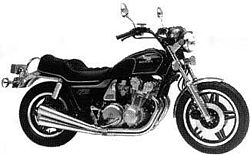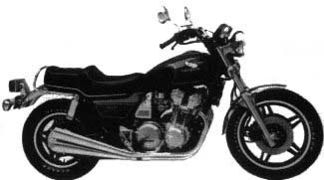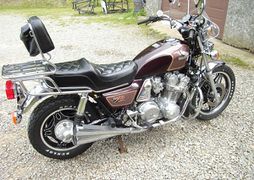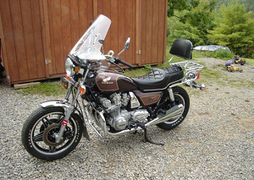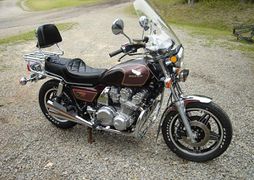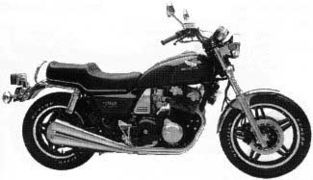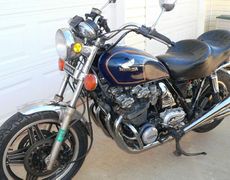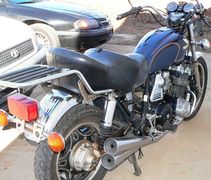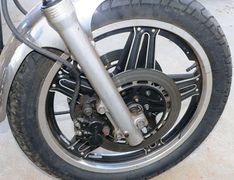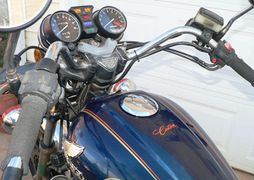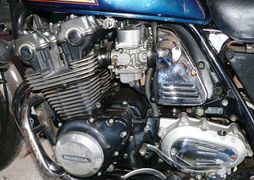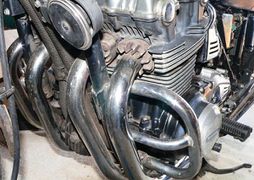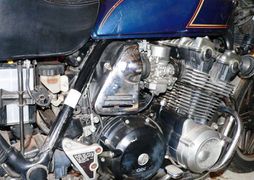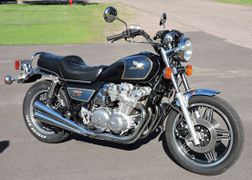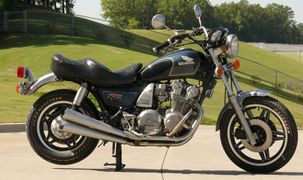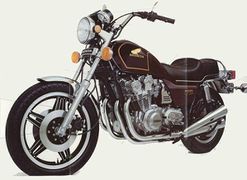Honda CB900C Custom: history, specs, pictures
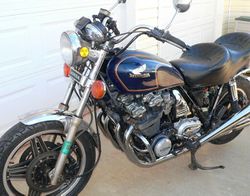 |
|
| Honda CB900C | |
| Manufacturer | |
|---|---|
| Production | 1980 - 1982 |
| Class | Cruiser |
| Engine | 902cc air-cooled DOHC 16-valve inline four, 4 valves per cylinder |
| Bore / Stroke | 63.5mm x 63.5mm |
| Compression ratio | 8.8:1 |
| Top Speed | 135 mph |
| Horsepower | 94.94 HP (70.8 KW) @ 9,000 RPM |
| Torque | 56.8 ft/lbs (77.0 Nm) @ 8,000 RPM |
| Fuel System | 4x32mm Keihin carburetors |
| Spark Plug | NGK DR8ES '80-82 |
| Battery | YUASA YB14L-A2 '80-82 |
| Transmission | 5 Speed with additional hi/low for 10 speeds |
| Final Drive | Shaft |
| Suspension | Front: 37mm Air assisted forks, Rear: Dual air assisted shocks, |
| Brakes | Front: 2x 280mm discs 2 piston calipers Rear: Single 297mm disc 1 piston caliper |
| Front Tire | 110/90-19 '80-82 |
| Rear Tire | 130/90-16 '80-82 |
| Weight | 588lb (wet) |
| Oil Filter | K&N KN-401 |
| Recommended Oil | Honda GN4 10w40 |
| Fuel Capacity | 16 Liters / 4.2 US gal |
| Related | Honda CB900F Honda CB1000C |
| Competition | Suzuki GS850 Suzuki GS1100GL Yamaha XS1100 |
| Manuals | Service Manual |
The Honda CB900C is a "custom"-styled standard motorcycle produced by Honda from 1980 to 1982. It used the engine from the Honda CB900F and transplanted into a factory "custom" cruiser.
History[edit | edit source]
The slightly modified and larger displacement CB1000C was produced in 1983 only. It is a derivative of the DOHC CB750K at the supposed requests of the American consumer, according to Rider magazine, March 1980. It is equipped with a handful of features that are unique for its time. These included air assisted suspension front and rear, shaft drive from the GL1100 Goldwing of the same time period, and most notably, a dual range sub-transmission that allows the operator to "split" any of the five gears in the main transmission for a total of ten driveline ratios. The CB900C is closely related to the Honda CB900F and the 1983-only Honda CB1100F (both derivatives of the CB750 line).
An air/oil cooled DOHC 902cc engine with 4 32 mm Keihin CV carburetors and electronic pointless ignition produces 84 BHP @ 8500 RPM. Front suspension relies on air pressure for preload while the rear relies more on air for the actual spring action. Three disk brakes arrest the momentum of the considerable curb weight as listed in the Honda FSM (Factory Service Manual) as 611 pounds or 277 kg.
Both Rider and Cycle World reviewed this motorcycle in 1980 with varying degrees of disregard and dissatisfaction. The top complaints were the lack of purity in the "custom" styling and its effect on function regarding sport or spirited riding. The soft suspension was recorded as a hindrance to cornering ability as was the highly reactive shaft-drive/sub-transmission combination and the huge mass of the machine in general. Comparisons were made to tractor trailers. The bike garnered some appreciation from Cycle World for its styling and tank design.
The genesis of the CB900C makes it a "parts bin" bike. Honda produced two shaft drive bikes previous to and concurrently with the CB900C. The GL and CX series of touring motorcycles of the time are the source of the final drive and rear suspension assemblies of the CB900C. The European model CB900F supplied the basic frame extended two inches for the sub-transmission, engine, and many other chassis components. Full Hondaline touring equipment (Fairing, Lower Leg Fairings, Saddlebags and Trunk were available from the Honda dealer to make the CB900C a complete Touring Bike.
The Sub-transmission is used as a "jack shaft". That is, in order for Honda to use the CB900F engine in conjunction with the GL swingarm and final shaft drive, power must be taken from the CB900F's left hand power take off and transferred to the GL's right hand side final drive shaft. The "Jack Shaft" was given 2 gear ranges ranges at relatively low cost. Most CB900C riders use the 2-Speed Transmission more like 6th gear overdrive. Leaving the bike in low range while shifting through the normal 5 gears, then shifting into high range once up to speed on highway, reducing engine rpm significantly at touring speeds.
Despite the lackluster treatment of the bike by the media some 27 years ago, the CB900 Custom has gained a small cult following. This phenomenon is not due to any one particular attribute of the cycle, but rather to a culmination of appreciation for its uniqueness (10 speeds), styling, comfort, reliability, and ample power output. "It looks like a bike should look," says a member of the "CB900C CB1000C Custom Club" on Yahoo! groups (well over 2,000 members strong). The CB900C CB1000C Custom Club had been around in its current form since September 14, 2000 and existed on many other forums for several years before settling on the Yahoo! Groups forum. One of main reasons for the clubs existence is to help owners get as many of these bikes as possible back on the road.
1980[edit | edit source]
The CB900C'80 900 Custom was sold in 1980 and was available in one of two color: Candy Muse Red or Candy Poseidon Blue. The pinstripes were gold and red. The exhaust was a 4-into-4. The transmission was a 5-speed with a dual range sub-transmission thus giving it 10 actual speeds. The engine was a 902cc DOHC 4- valve inline 4 cylinder with a shaft drive. The serial number began SC04-2000046.
1981[edit | edit source]
The CB900C'81 900 Custom was sold in 1981 and was available in one of two color schemes: Candy Muse Red with Brown Metallic or Cosmo Black Metallic with Blue Metallic. The gas tank and side covers were 2-tone. The front forks were leading-axle and air adjustable. The exhaust was a 4-into-4. The transmission was a 5-speed with a dual range sub-transmission thus giving it 10 actual speeds. The engine was a 902cc DOHC 4- valve inline 4 cylinder with a shaft drive. The serial number began 1HFSC040*BA100004
1981 Honda Motorcycle Full-Line Brochure
1982[edit | edit source]
The CB900C'82 900 Custom was sold in 1982 and was available in one of two color schemes: Candy Muse Red with Candy Antares Red or Candy Empire Blue with Candy Blue. The engine color was black. The front brake discs were slotted with dual piston calipers. The gas tank and side covers were 2-tone. The front forks were leading-axle and air adjustable. The exhaust was a 4-into-4. The transmission was a 5-speed with a dual range sub-transmission thus giving it 10 actual speeds. The engine was a 902cc DOHC 4-valve inline 4 cylinder with a shaft drive. The serial number began 1HFSC040*CA200101.
Review[edit | edit source]
Road Test Cycle 1980 "Oh, do not ask, 'What is it?' Let us go and make our visit." T.S. Eliot Honda's cb900 custom is a bit of an enigma, to us and perhaps even to its creators. According to our sources at American Honda, the 900 wasn't intended for the touring rider, yet it definitely has some of a touring bike's attributes. Neither is it a road-sport model, though it was directly derived from one of the most sporting motorcycles Honda has ever made for sale to the public. And despite having officially been designated a "custom," the CB900 isn't quite that, either. The only thing it clearly is, is a marketplace competitor for the Suzuki GS850 and Yamaha XS850; on that basis shall it be judged, by us and everyone.
The CB900 has an interesting lineage. It was initially a bored and stroked version of the 16-valve CB750F, made for the European market and introduced there last year. Honda opened the 750's bores from 62 to 64.5 millimeters, stretched its stroke (also 62mm) to 69mm, and thus increased its displacement to 902 cubic centimeters. They made the stroker crank's webs thicker, lengthened the block and rods, upped the intake and exhaust valve diameters by 1.0 and 0.5mm, respectively, and added five degrees of duration at the cam lobes' opening sides. There were other performance-related changes as well, because what Honda wanted (and by all accounts succeeded in making) was a super-sport motorcycle capable of holding its own on Europe's no-speed-limit highways. To that end, they even gave the European CB900 an oil cooler as standard equipment'. . . an item not usually necessary in America, where the law's admonition to "cool it" tends also to keep oil temperatures low. We'll admit that we'd have been well pleased if Honda had decided to fit the European CB900 with DOT lighting, EPA carburetion, and sent it here without making another change. That was not to be. Europe's CB900s are chain driven, and Honda wanted a shaft-drive model to slip into the broad product gap between the GL1100 and CX500 shafties. The bike got its drive shaft, along with many added pounds and a greatly lengthened wheelbase. So, to borrow from the beer commercial, the Americanized CB900 gives you more, and less: more civility, less performance. Honda's American CB900 would not be so long of wheelbase, nor mechanically quite so interesting, if those who designed it had not chosen to use a maximum of existing hardware. Specifically, they opted to work with only lightly altered CB900 nee CB750F engine/transmission cases and the GL1100-CX500 final-drive assembly. This approach, like making the CB900 out of the CB750F, was shaped by manufacturing economics. They had to couple a left-side transmission output stub to a right-side final drive, and the twain could not be made to meet without taking complicated measures.
What Honda's engineers did to resolve their right-to-left dilemma was to cobble together some transfer gears, a jack-shaft and right-angle bevel drive in a housing that wraps around the left side and rear of the main transmission case but is not inseparably a part of it. They also doubled-up the transfer gears, which occupy space originally taken by a sprocket, and added a shifting dog, etc., to give the CB900 a two-speed secondary transmission. And although the entire exercise was prompted by cost considerations they did not stint in building reliability into their cross-over drive unit. It is a very strongly constructed piece of equipment, with its own oil supply and a small trochoidal pump to keep its bevel gears lubricated; splash oiling takes care of the transfer gears.
There certainly was some justification for the two-speed feature of the drive. Gold Wing owners never have been able to agree on the overall gearing their bikes should have: some want the ratio "tall," for low-stress cruising; others, habituated to hauling big loads and pushing bulky fairings, prefer the shorter gearing that lets them pull steep grades without downshifting. The CB900's Select Range feature provides two overall ratios. There's a 5.26:1 ratio (in fifth gear) for mountain or urban conditions, and a 4.50:1 ratio for economical cruising.
You can get economy, both in fuel mileage and engine life, by using the Select Range's high gear for cruising. In fifth/low the CB900's engine spins 4378 rpm at 60 mph; in fifth/high it turns only 3745 rpm, and feels like it's idling. There's a dramatic difference in fuel economy, too, which hints that the power engines need merely to overcome their own friction is significant. We rode the CB900 on a long loop around this area's freeways, first in fifth/low and then in fifth/high. Low-range riding returned 41.8 mpg; in high the mileage rose to 48.6 mpg. Using low-range for a period of maximum-effort performance and handling testing brought the CB900's mileage down to 28.5 mpg, and the overall average for the entire test was 37.2 mpg. That fuel consumption rate would give the Honda 164 miles before its 4.4-gallon tank empties, but running at a steady 60 mph would stretch the range to 184 miles if you keep it in granny, or 214 miles if you use the overdrive.
Whatever drive ratio you select, it's a long path for power to get from the CB900's crank to its rear wheel. A broad Hy-Vo chain links the crank with a jack-shaft, which has a vane-type rubber-loaded drive cushion at its center and spur gears at each of its ends. The leftside gear drives the engine's oil pump; the one on the right meshes with a pair of gears on the clutch basket. Only one of the clutch-basket gears actually participates in the drive; its mate, also straight-cut but much narrower, has one fewer teeth than the driven pinion and therefore rotates slightly faster. This causes a scrubbing drag between the two gears that takes up lash in their meshing with the jackshaft pinion, which keeps this part of the drive train from rattling.
Interesting lineage: Honda's 16-valve CB750F, made for America, begat the European CB900, which begat the shaft-drive American CB900 Custom seen here. After passing through the clutch, the drive goes through a conventional constant-mesh five-speed transmission hopping across from input to output shafts, and then to the secondary transmission's gears, shafts and bevels before being sent back to yet another pair of gears at the rear axle. There are, in all, 20 gears, six shafts, a dozen bearings, three torque cushions, a U-joint and assorted couplings employed in making the crank/rear-wheel connection. Something in the above train puts too much lash in the CB900's drive. Our prime suspect is the cam-type drive cushion that's incorporated in the crossover unit's jackshaft. Whatever the source of the lash it's there and it's bothersome, especially in first and second gears. Going too quickly from closed to open throttle, or vice versa, gets you yanks and lurches the like of which you won't find in any other motorcycle presently in production. A portion of the on/off-throttle lurching may be contributed by the 32mm CV-type Keihin carburetors. These get off-idle help from an accelerator pump, which discharges into all four throats, but there still is a slight hestitation in the low-speed throttle response to aggravate the effects of drive-train lash. That's the only carburetion flaw. EPA-dictated jetting has made the mixture lean enough so that a bit of choking is needed for starting if the engine is just cool, not cold, but you won't have to use the choke for more than a minute even in the morning chill. The CB900 isn't as cold-blooded as many of the pre-EPA Hondas.
In most ways the CB900's engine is a pure pleasure, whether it's touring, drive-in visiting or home/work commuting you've asked it to do. It has the general power-delivery characteristics of an electric motor, with its torque seemingly independent of tachometer readings. There isn't the top-end power you'd expect from an engine with so many valves and long-duration cams, and this makes the CB900's real-world performance better than its drag-strip numbers suggest. Our best quarter-mile run was in 12.76 seconds, at 104.89 mph, which is two-tenths of a second slower than the best time turned by Honda's spirited CB750F. But the CB900, running with its Select Range box in low, will fifth-gear accelerate very briskly and even at the drag strip where it isn't at its best it's both quicker and faster than the Suzuki GS850 or Yamaha XS850. The CB900 is 0.21 second quicker than the GS850, with an essentially identical speed; it totally out-performs the 13.26-second, 101.46-mph Yamaha triple. Nothing else in the CB900's class, and few outside it, can equal its ride quality. The bike doesn't quite have enough rear-wheel travel to cope with its weight, and bottoming can occur under certain conditions, but the new leading-axle fork is wonderfully compliant and if you adjust the suspensions full-soft you'll feel like you're riding on airwhich is exactly the case. Honda has given the CB900 steel springs, but they're there just to keep its suspensions from collapsing completely against their stops in the event that air pressure should be lost.
Honda's first version of the American CB900 had a center-axle front fork; this new one, a 1981 model, has similar 37mm fork tubes but leading-axle sliders. We don't know why the change was made. The new fork's tubes are angled back a little in their triple-clamps to place the axle right where it was before, so there's no appreciable alteration in steering geometry. And the below-axle portions of the new sliders are hollow, mere adornments promising but not delivering extra travel and/or slider overlap. In fact, the 6.1 inches of fork travel is just what it was before. Apparently, all the fork's changes are for styling. Although closely similar to the Gold Wings', the CB900's shocks are different parts. In design, these units are not unlike short, inverted fork legs. Each has two coil springs, but their resistance to compression is supplied mostly by air pumped into the shock's interiors. Air is added, or bled off, through a single fitting located behind the bike's left sidecover. Honda recommends pressurizing the shocks to between 28 and 64 pounds per square inch, and has provided a sensor that lights a warning lamp on the tachometer face if the pressure drops below 20 psi. The shocks' internal coil springs do keep them from telescoping completely down against their stops when pressurization is lost, but most of the 3.8 inches of travel is gone when they're airless, and a decal by the warning lamp tells you to keep the CB900's speed below 50 mph when the lamp is glowing red.
Honda's recommendation for fork pressure is 11 to 16 psi. You can get close to the ultimate in floaty rides by running minimum pressures, front and rear; that's not what we'd suggest. After some experimentation we settled on 45 psi as the best rear shock pressure for all-conditions solo riding, and we used 14 psi in the fork. At that pressure the CB900's stiction-free fork responds with near-total compliance to small ripples and highway expansion seams, yet it stiffens enough in the second half of its travel to keep braking nose-dive from upsetting stability. Higher pressures may be needed to adjust for "full-dress" loads, but when riding solo they make the ride slightly stiff without yielding any payoff in improved handling.
Most riders will judge the CB900's steering and overall road manners
satisfactory. It's straight-line stable at normal and reasonably fast cruising
speeds, though traces of wobble begin to appear as the speedometer needle
approaches the instrument's DOT-mandated, 85-mph limit peg. You will need to
apply some muscle at the bike's handlebar to whip it through fast esses quickly,
but the steering is nicely neutral so you don't have to fight to hold a line
once you've stuffed the CB900 into a corner. Few people will want to do much
corner-stuffing with this Honda: it weighs too much (610 pounds) and is too
bulky for such games, and would be a handful even if it had firmer suspension
damping and more cornering clearance.
For sheer wheelbase, Honda's CB900 is one of the giants of our timebeing
only 0.3 inch shorter than the Harley-Davidson-FXE "Fat Bob" Super Glide. Honda
needed wheelbase to make room for an absolutely enormous engine bay; they
devoted remarkably little of the space to the CB900's swing arm, which is too
short to subdue the shaft drive's torque jacking effects. The Yamaha XS850 and
Suzuki's GS850 are also shaft-driven motorcycles, and the latter is only five
pounds lighter than the CB900. Both handle better and neither has the Honda's
habit of lifting and falling when its throttle is opened and closed.
What price reliability? Honda cobbled together eight gears, three shafts, a U-joint, an extra torque cushion and many seals and bearings just to replace a length of chain.
One genuine improvement Honda made in the CB900 for 1981 was in its tires. These are the same sizes as beforea 110/90-19 up front and a 130/90-16 at the rear. Both tires are H-rated, as before, but they're now tube-less, which we consider a step forward. Two kinds of tires will be fitted on 1981 CB900s: Dunlop Qualifier, and Bridge-stone Mag Mopus. Our test bike had the Dunlops, which provided adequate dry-road traction and a smooth ride, along with a couple of minor problems. The rear tire has rather tall, straight sidewalls and these flex sideways enough to be felt as a squirming at the Honda's rear when it is worked hard in fast turns.
Also, California's infamous freeway rain-grooves caused the semi-ribbed front
tire to weave slightly, though not enough to be worrisome.
Motorcycles with the Honda's weight and capacity for sprinting rapidly
between corners give their brakes a serious workout. Not all of them have brakes
that hold up as well under the strain as the CB900's. Its three disc rotors
turned faintly straw-colored from the temperatures reached during one long
session of mountaineering, and even that wasn't enough to destroy their
effectiveness. Heat made the brake pads literally smoke; it didn't glaze them or
warp the stainless steel rotors, and the brakes continued to do their job. The
only ill-effects noted during this phase of our testing were an elevation of
lever-pressure requirement with extremely high temperatures and a deterioration
of brake feel. At normal working temperatures there's a linear relationship
between squeezing and stopping; when the pads begin to smoke the lever feels
spongy, the braking is weak at moderately hard lever pressures, and tends to
shudder and grab if you attempt a maximum-effort stop. The rear brake neither
fades nor loses its feel, but then it isn't worked nearly as hard as the
dual-disc unit on the front wheel.
The CB900's split-level seat has been upgraded for 1981 ... or so it is said.
There's supposed to be thicker padding under the seat's forward half, and a
reshaped step, but the differences are too slight to be noticeable. No matter:
the Honda is perfectly comfortable to ride, for as long as you can stand being
in the one position it allows you to assume. The seat is low (only 30.8 inches
from the ground) and that makes the reach to the pegs a tad short for
long-legged riders, but the handlebar-grip placement is exactly right and the
tapered tank has been shaped by someone who paid attention to the inner contours
of human knees and thighs. The only thing wrong with the CB900's seating
position is that it's rigidly enforced; the seat locks you in place, and however
well you like it for 15 minutes you'll wish you could move around some after an
hour of riding.
You won't have the effects of engine vibration to massage your numbed backside. Honda has inserted rubber bushings in the CB900's engine mounts, and achieved a remarkable degree of smoothness at all speeds from just past idle to 6000 rpm. There isn't much engine vibration detectable at any speeds. You feel tremors at idle and a subdued buzz above 6000 rpm; that's all.
Honda hung a big outside-flywheel alternator on the CB900, giving the
crankshaft some added inertia and providing an adequate power source for the
bike's superb Stanley headlight. This quartz-halogen lamp draws 55 watts on low
beam, 60 watts on high beam, and puts out enough light on either beam to crinkle
the paint on stop-signs. For 1981, the electrical system also includes dual
horns, which may not be mellow but most certainly are loud. Also new is the
'81's instrument lighting: Honda has gone to shine-through illumination, with
bulbs behind the instruments' faces.The markings glow in a pale green, highly
readable yet restful to the eyes.
The CB900 comes about as near to being a service-free motorcycle as we are likely to see anytime soon. Its ignition system is pointless, its cam chain is automatically tensioned and its cooling system (plan fins) can never spring a leak. Keep an eye on the bike's three oil dipsticksengine/transmission, Select Range transfer case, and final drive and various air pressures, and you won't have much trouble. The infrequent post-warranty valve clearance adjustments should be made by an authorized Honda shop, which saves aggravation even if it costs money. You have to slide the battery sideways out of its mounting box to check electrolyte levels in the cells, but the retaining strap is held by a single cap-screw so this chore is easily managed. And removing two screws (on the leftside airbox cover) will give you access to the air filter element. There isn't much you'd want to do, including removing the CB900's wheels, that can't be done using just the tools provided with the standard tool-roll. You even get an air gauge for checking the tire and suspension inflation pressures.
American Honda informs us that the 1981 CB900 Custom we tested will not be
available at dealerships until early October, this year. They anticipate that
the retail price of the "new" model will be approximately $150 to $200 more than
the $3348 being asked for the 1980 Custom. That means it probably will be a
price roughly $200 to $300 greater than you'd pay for a Suzuki GS850 or Yamaha
XS850, which is a matter of greater import than whether you should buy the
less-expensive 1980 CB900 or wait until the 1981 version is available. The
differences between the 1980 and 1981 CB900s are mostly cosmetic; the extra
money for the later model buys you tube-less tires, shine-through instruments,
an extra horn and a "demand" automatic fuel petcock as functional hardware.
But there are large differences between the Honda CB900, Suzuki GS850 and
Yamaha XS850. Go for the Yamaha and you get lightness and agility, with a
suspension that is almost as compliant as the Honda's and much better
controlled. The Yamaha also out-customs the CB900 Custom's looks, for whatever
that's worth. The Suzuki GS850 is recommended by superb handling and what we
consider supreme agreeability, with performance only fractionally inferior to
the Honda's. With the Honda CB900 Custom you treat yourself to what probably is
the best ride in motorcycling, strong straight-line performance, a look and
quality of finish most people will admire, and maybe the most comfortable
short-haul seating position ever provided between two wheels. If those are
things you find most appealing, then the Honda CB900 Custom is the bike for you,
whether you buy a 1980 model right now or wait for the 1981; whether it's better
or worse in other ways than the Suzuki or Yamaha; and whether it is called a
touring bike, a road-sport model, or a "custom."
Source Cycle 1980
Specifications[edit | edit source]
| Make Model | Honda CB 900 Ccustom |
|---|---|
| Year | 1980 |
| Engine Type | Four stroke, transverse four cylinder, DOHC, 4 valve per cylinder. |
| Displacement | 901 cc / 54.9 cu-in |
| Bore X Stroke | 64.5 X 69 mm |
| Cooling System | Air cooled, |
| Compression | 8.8:1 |
| Lubrication | Wet sump |
| Induction | 4x 32mm Keihin carburetors |
| Ignition | Inductive electronic |
| Starting | Electric |
| Max Power | 95 hp / 70.8 kW @ 9000 rpm |
| Max Torque | 77 Nm / 56.7 lb-ft @ 8000 rpm |
| Clutch | Air cooled, |
| Transmission | 5 Speed |
| Final Drive | Shaft |
| Front Suspension | 37mm Air assisted forks, |
| Front Wheel Travel | 155 mm / 6.0 in |
| Rear Suspension | Dual air assisted shocks, |
| Rear Wheel Travel | 97 mm / 3.8 in |
| Front Brakes | 2x 280mm discs 2 piston calipers |
| Rear Brakes | Single 297mm disc 1 piston caliper |
| Front Tire | 110/90-19 |
| Rear Tire | 130/90-16 |
| Dry Weight | 277 kg / 611 lbs |
| Fuel Capacity | 16 Liters / 4.2 US gal |
| Consumption Average | 41.2 mpg |
| Standing ¼ Mile | 11.9 sec / 177.8 km/h |
| Top Speed | 135 mph 217.3 km/h |
References[edit | edit source]
| ||||||||||||||
